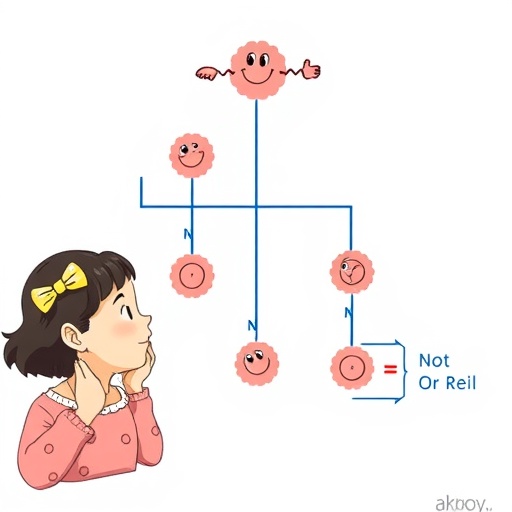In recent years, the topic of autism spectrum disorders (ASD) has drawn increased attention from researchers, clinicians, and the public alike. This heightened interest is driven largely by the growing number of individuals diagnosed with ASD, highlighting the need for comprehensive understanding and effective intervention strategies. One of the key areas of research has focused on the dimensional characteristics of repetitive and restrictive behaviors (RRBs), essential components of the ASD phenotype.
A new study led by researchers Grzadzinski, Tapia, and Mata seeks to illuminate the factor structure of RRBs specifically in preschoolers, an age group that has been underrepresented in comparable research. Verbal and non-verbal preschoolers with ASD or related characteristics were at the center of this analysis, providing crucial insights into how these behaviors manifest at a critical stage of development. This study is a milestone, as it ventures into a particularly vulnerable age demographic where early intervention is vital for better long-term outcomes.
Prior studies often focused on older children, adolescents, or adults, leaving a significant gap in our understanding of how RRBs develop and vary among younger individuals with ASD. In this latest research, the authors emphasize the importance of examining both verbal and non-verbal preschoolers, as their developmental trajectories may differ significantly. The nuanced understanding of RRBs in this age group can facilitate tailored interventions, enabling caregivers and educators to support their growth more effectively.
The research team employed a robust methodology to evaluate the presence and impact of various RRBs exhibited by the subjects. Using a combined qualitative and quantitative approach, the researchers meticulously gathered observational data and parent-reported outcomes to form a comprehensive picture of behavioral expressions. The study demonstrates how incorporating parental insights can enrich the understanding of a child’s experiences, enhancing the fidelity of the results obtained.
Data analysis revealed distinct clusters of RRBs among the preschoolers studied. This clustering not only reinforces the heterogeneous nature of ASD but also suggests that different types of RRBs may serve varied functions or stem from underlying cognitive and emotional processes. Identifying these factors is imperative for creating customized interventions aimed at diminishing maladaptive behaviors while enhancing beneficial habits.
Interestingly, the study found a significant overlap in RRBs between verbal and non-verbal preschoolers, albeit with some differential manifestations. Verbal children exhibited more complex forms of repetitive behaviors, often linked to imaginative play or social interactions, while non-verbal children displayed more straightforward forms of restriction and repetition. This finding speaks volumes about the cognitive capabilities that influence how these behaviors unfold, reinforcing the premise that verbal communication can lead to varied behavioral expressions.
By thoroughly dissecting the factor structure of RRBs, the researchers aim to build a clearer framework for understanding the psychological underpinnings of these behaviors. Their findings propose that RRBs should not be viewed merely as deficits or challenges but also as potential avenues for structuring interactions and facilitating learning among children with ASD. This perspective encourages a shift in approach toward positive reinforcement and skill-building rather than solely focusing on behavior modification.
As we venture deeper into the digital age of information, sharing knowledge and insights gained from such studies becomes crucial. Parents, educators, and clinicians can greatly benefit from understanding the intricacies highlighted in this research. By fostering a community of informed stakeholders, it may be possible to bridge the gap between research and practice, better addressing the multifaceted needs of children with ASD.
Equally crucial is the consideration of cultural and environmental factors that may influence the expression of RRBs. The researchers call for future studies to take into account diverse backgrounds and settings, as cultural context plays a significant role in how children develop and exhibit behavioral traits. A broader understanding of these variables can pave the way for more globally-applicable frameworks that consider the unique experiences of individuals across different cultures.
As preliminary findings from this study emerge, it is fitting to reflect on how these insights might influence future research directions. Broader samples, longitudinal studies, and comparative analyses with typically developing peers could propel this field forward, ensuring that our understanding of ASD continues to evolve in alignment with the lived experiences of those affected.
The urgency surrounding the research topics of ASD and RRBs cannot be overstated. Parents are often seeking answers and supportive structures to assist their children through challenges. At the same time, professionals strive to refine techniques that lead to meaningful outcomes for this population. The discourse generated by studies such as this highlights that collaborative efforts among researchers, practitioners, and families are paramount for a holistic understanding of developmental trajectories.
In conclusion, Grzadzinski et al.’s study represents a significant contribution to the ongoing investigation of autism spectrum disorders, particularly in exploring the factor structure of RRBs. By delving into the complexities faced by both verbal and non-verbal preschoolers, the authors illuminate pathways for future research while advocating for tailored intervention strategies. This research not only enriches academic discourse but also ensures that the voices of young children are heard and prioritized within the ever-evolving landscape of autism studies.
Subject of Research: Analysis of RRBs in verbal and non-verbal preschoolers with ASD
Article Title: Factor Structure of RRBs in Verbal and Non-Verbal Preschoolers With ASD or Related Characteristics.
Article References:
Grzadzinski, R., Tapia, A.L., Mata, K. et al. Factor Structure of RRBs in Verbal and Non-Verbal Preschoolers With ASD or Related Characteristics. J Autism Dev Disord (2025). https://doi.org/10.1007/s10803-025-07114-1
Image Credits: AI Generated
DOI: https://doi.org/10.1007/s10803-025-07114-1
Keywords: Autism Spectrum Disorders, Repetitive Behaviors, Preschoolers, Verbal Communication, Non-Verbal Communication.




